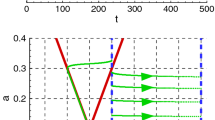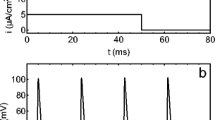Abstract
We constructed a computer model of 128 interneurons, each with multiple dendritic branches and an axonal segment. The model neurons were interconnected by gap junctions between dendritic compartments, as are known to occur in rat and guinea-pig hilar interneurons. The model contained no excitatory synapses. In the presence of low-frequency spontaneous action potentials, the model generated synchronized population bursts, when gap junction resistance was 50 MΩ and there were at least two gap junctions per neuron on average. Population bursts occurred only when the dendrites of model neurons were electrically excitable. Consistent with experiment, somatic hyperpolarization during the population burst uncovered partial spikes. In the model, partial spikes originated in electrically active dendrites driven by coupled dendrites. This model may account for population bursts in hilar interneurons that occur in 4-aminopyridine (4AP) together with blockers of GABAA and excitatory amino acid (EAA) receptors.
Similar content being viewed by others
References
Bennett MVL (1977) Electrical transmission: A functional analysis and comparison to chemical transmission. In: ER Kandel, ed.Handbook of Physiology Section 1: The Nervous System Vol. 1, Part 1, Cellular Biology of Neurons, American Physiological Society, Bethesda, pp. 357–416.
Buhl EH, Han Z-S, Lörinczi Z, Stezhka VV, Karnup SV, Somogyi P (1994) Physiological properties of anatomically identified axoaxonic cells in the rat hippocampus.J. Neurophysiol. 71:1289–1307.
Erdös P, Rényi A (1960) On the evolution of random graphs. Publications of the Mathematical Institute of the Hungarian Academy of Science (A Matematikai Kutató Intézet Közleményei) 5:17–61.
Grinnell AD (1970) Electrical interaction between antidromically stimulated frog motoneurones and dorsal root afferents: Enhancement by gallamine and TEA.J. Physiol. 210:17–43.
Gulyás AI, Miles R, Sik A, Tóth K, Tamamaki N, Freund TF (1993) Hippocampal pyramidal cells excite inhibitory neurons via a single release site.Nature 366:683–687.
Katsumaru H, Kosaka T, Heizmann CW, Hama K (1988) Gap junctions on GABAergic neurons containing the calcium-binding protein parvalbumin in the rat hippocampus (CA1 region).Exp. Brain Res. 72:363–370.
Kosaka T (1983) Neuronal gap junctions in the polymorph layer of the rat dentate gyrus.Brain Res. 277:347–351.
Michelson HB, Wong RKS (1991) Excitatory synaptic responses mediated by GABAA receptors in the hippocampus.Science 253:1420–1423.
Michelson HB, Wong RKS (1994) Synchronization of inhibitory neurones in the guinea pig hippocampusin vitro.J. Physiol. 477:35–45.
Miles R (1990) Synaptic excitation of inhibitory cells by single CA3 hippocampal pyramidal cells of the guinea-pigin vitro. J. Physiol. 428:61–77.
Miles R (1991) Tetanic stimuli induce a short-term enhancement of recurrent inhibition in the CA3 region of guinea-pig hippocampusin vitro.J. Physiol. 443:669–682.
Miles R, Poncer J-C (1993) Metabotropic glutamate receptors mediate a post-tetanic excitation of guinea-pig hippocampal inhibitory neurones.J. Physiol. 463:461–473.
Newberry NR, Nicoll RA (1984) A bicuculline-resistant inhibitory post-synaptic potential in rat hippocampal pyramidal cellsin vitro.J. Physiol. 348:239–254.
Otis TS, De Koninck Y, Mody I (1993) Characterization of synaptically elicited GABAB responses using patch-clamp recordings in rat hippocampal slices.J. Physiol. 463:391–407.
Stasheff SF, Hines M, Wilson WA (1993) Axon terminal hyperexcitability associated with epileptogenesis in vitro. I. Origin of ectopic spikes.J. Neurophysiol. 70:960–975.
Traub RD, Colling SB, Jefferys JGR (in press) Cellular mechanisms of 4-aminopyridine-induced synchronized after-discharges in the rat hippocampal slice.J. Physiol.
Traub RD, Jefferys JGR, Miles R, Whittington MA, Tóth K (1994) A branching dendritic model of a rodent CA3 pyramidal neurone.J. Physiol. 481:79–95.
Traub RD, Miles R (1991)Neuronal Networks of the Hippocampus, New York: Cambridge University Press.
Traub RD, Miles R (1995) Pyramidal cell-to-inhibitory cell spike transduction explicable by active dendritic conductances in inhibitory cell.J. Comput. Neurosci. 2:291–298.
Traub RD, Miles R, Jefferys JGR (1993) Synaptic and intrinsic conductances shape picrotoxin-induced synchronized after-discharges in the guinea-pig hippocampal slice.J. Physiol. 461:525–547.
Whittington MA, Traub RD, Jefferys JGR (1995) Synchronized oscillations in interneuron networks driven by metabotropic glutamate receptor activation.Nature 373:612–615.
Author information
Authors and Affiliations
Rights and permissions
About this article
Cite this article
Traub, R.D. Model of synchronized population bursts in electrically coupled interneurons containing active dendritic conductances. J Comput Neurosci 2, 283–289 (1995). https://doi.org/10.1007/BF00961440
Received:
Revised:
Accepted:
Issue Date:
DOI: https://doi.org/10.1007/BF00961440




